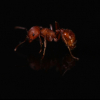Pogonomyrmex isn't too much a beginner friendly species. They aren't hard though. I found ones I got by the beach/coastal areas died super fast. Like within 2-3 days fast. But, with that said, the ones out in the desert are vastly easier. Even though both that I got were Pogonomyrmex californicus, I found far more success if I got them out east instead of closer to the coast. The ones in the desert are far hardier and a lot faster too than the coastal/local variety. Overall, I found Veromessor to be a lot easier, but hard to find a queen of them. With that said, the Pogonomyrmex californicus I've found locally in Irvine seem to do really good, just ones right by the coast seem to die too fast in captivity.
Locally. I found Solenopsis invicta (which are much bigger than the native Solenopsis, AND rival the size of smaller Pogonomyrmex californicus workers) were far easier. They are so easy that even the worst ant keeper wouldn't have an issue with them. They were my first successful species. But, you'll have an issue of dealing with a huge population, very fast. My colony had one queen and 200 workers or so, and grew to over 100,000 ants in 6 months. But, they are actually pretty large (the ones in Irvine anyway). Even my current Pogonomyrmex californicus I have, are smaller than the bigger S. invicta majors I've found. Not many people may know, and it may depend on the area, but S. invicta are actually pretty big (I'd consider them a medium size ant for the majors, workers are smaller though). You can get S. invicta easily too, but if you dig into their mound, be prepared for a lot of ant stings.  Can try flooding the mound, be easier.
Can try flooding the mound, be easier.
A bit of a different suggestion, but probably not recommended. But, Acromyrmex versicolor are really easy and very active. Out of all the Leafcutters, they are probably easiest. I wouldn't recommend them for a first ant or second or even third ant though, but mine have been so far as easy as my S. invicta ever were. In some ways easier, because I don't have to worry about insects and barely have to do anything with them except watch them.  The hardest part is a formicarium design for them, but even that doesn't sound too hard. Someone in my journal of them said he just has an acrylic box with a wet cotton in a hole that soaks up water. Although I may find them easier just because I did a ton of research, reading others journals and have kept ants for a long time lol.
The hardest part is a formicarium design for them, but even that doesn't sound too hard. Someone in my journal of them said he just has an acrylic box with a wet cotton in a hole that soaks up water. Although I may find them easier just because I did a ton of research, reading others journals and have kept ants for a long time lol.
I find Camponotus to be overall really hard, despite what Drtrmiller suggested. Most people don't have an issue with them, but when I keep them they get to worker stage and the workers die right away. And then it always takes 6-9 months for workers to eclose, even though I keep them in a really warm garage. No idea why, but that is one ant that I am no good with.  With that said, I found Camponotus modoc vastly easier and they got workers in 3 and a half weeks, but those I found way up in northern california. I don't think you can find them down there. They were only Camponotus species I ever kept that did good though. All the Camponotus I find down here just do so terrible for me personally. No idea why I'd be so good with Camponotus modoc and not the others though, but oh well.
With that said, I found Camponotus modoc vastly easier and they got workers in 3 and a half weeks, but those I found way up in northern california. I don't think you can find them down there. They were only Camponotus species I ever kept that did good though. All the Camponotus I find down here just do so terrible for me personally. No idea why I'd be so good with Camponotus modoc and not the others though, but oh well.
Another ant that is really easy, but its on the small side is Forelius pruinosus/mccooki. They are hard to see though (they are only a little bit smaller than Argentine ants, but its their coloring), but they always do good for me. And they are a VERY active ant species. I see them in 120 degree weather on pavement, the only ant that is out in that temperature. But, they are pretty small in size and their color kind of blends them into the desert environment. Huge colonies though and can have TONS of queens in them.
Edited by Vendayn, February 7 2016 - 2:43 PM.

















